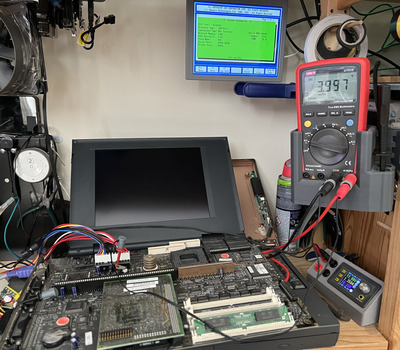First post, by feipoa
- Rank
- l33t++
It has been demonstrated elsewhere that the circuitry on the various 386 BL3 upgrade modules can cause issue on many 386 systems. Such modules shown here, download/file.php?id=43450&mode=view
It was recently shown here Re: 3 (+3 more) retro battle stations that we can take a PGA-132 to QFP-132 interposer and slap on an IBM Blue Lightning BL3, however this runs the BL3 at 5 V, so probably not good for long-term use.
I have begun work to remove the Am386DX from my PGA-132 to QFP-132 interposer and to remove the BL3 from one of my IODATA modules. I know the BL3 in the this particular IODATA module will work up to 110 MHz, albeit with flushing the cache every I/O.
In the photos, I'm showing the top (QFP) and bottom (PGA) of my interposer. On the top face, the centre region has a 5V Vcc plane. On the bottom, the centre square is the GND plane, with a 5V Vcc plane surrounding it. 13 of the 15 Vcc pins on the QFP side are connected to to that centre power plane, while 2 pins are connected to the power plane on the bottom through a via.
I would like to separate these two power planes so that I can re-purpose them for use with an AMS1117-ADJ voltage regulator and run the BL3 between 3.3 and 4.3 volts. Can this separation be accomplished by drilling out the 11 vias circled in red? The PGA pins look to be surface mounted and I don't think there's any inner traces.
Once drilled out, I would place the VRM on the bottom surface and wire it up. To get VRM's Vout to the top QFP layer's power plane, I was thinking to run 4 wires through the 4 larger vias and solder it to the power plane on the top. This would then be 3V Vcc rather than 5V. I'd probably glue a 1K trimmer to the top of the chip for adjustment. I'd also have to run the trimmer's wires though one of the large vias. The regulator's Cin and Cout would also go on the bottom side, alone with R1.
Plan your life wisely, you'll be dead before you know it.
